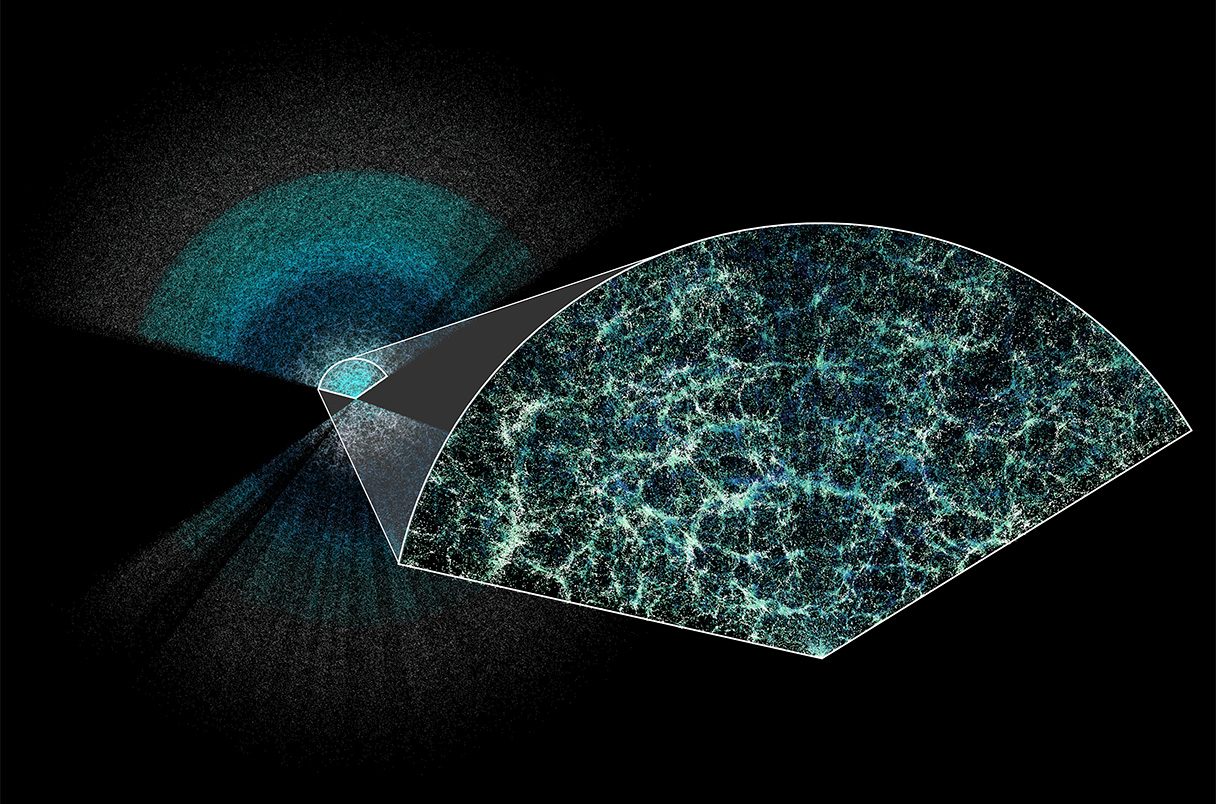Dark energy analysis is at the forefront of modern astrophysical research, offering insights into the mysterious force driving the universe’s accelerated expansion. Recent findings from the Dark Energy Spectroscopic Instrument (DESI) collaboration, which bolsters our understanding of this enigmatic phenomenon, suggest that the cosmological constant associated with dark energy may be diminishing over time. This pivotal discovery challenges long-held assumptions about the universe’s expansion and its ultimate fate. By leveraging the largest 3D map of the universe, created through data from over 14 million galaxies and quasars, scientists can trace the effects of dark energy over the last 11 billion years. As experts continue to unravel this cosmic enigma, the implications for our understanding of the universe are profound, highlighting the critical role of DESI in shaping future astrophysical research.
Exploring the dynamics of cosmic acceleration, the examination of dark energy serves as a crucial aspect of understanding the universe’s expansion. This analysis involves evaluating the forces that influence the pace at which the cosmos is evolving, centering around the concept of a potential cosmological constant. The intricate work performed by international teams, such as the DESI initiative, applies innovative techniques to map and measure the staggering scale of the universe in three dimensions. By investigating how these astrophysical forces have shifted over billions of years, researchers aim to uncover new insights into the structure of space and matter. The ongoing pursuit of knowledge in this area not only enriches our cosmic narrative but also propels forward essential scientific dialogue about our universe’s past and future.
The Role of Dark Energy in Universe Expansion
Dark energy plays a pivotal role in the accelerating expansion of the universe. It is often described as a mysterious force or the cosmological constant, a term that originates from Einstein’s theory of General Relativity. Recent findings suggest that this force may not be as constant as previously thought. The Dark Energy Spectroscopic Instrument (DESI) focuses on understanding this enigmatic force by mapping out the distribution of galaxies and other cosmic structures, allowing researchers to derive essential insights into how dark energy might be evolving over time.
As studies progress, astronomers are finding increasingly compelling evidence that dark energy’s impact could be influenced by myriad factors, leading to potential changes in the standard model of cosmology. By analyzing ancient light from billions of years ago, DESI provides a unique lens through which scientists can analyze how dark energy has affected the universe’s growth. This research not only enhances our understanding of dark energy but also contributes to astrophysical research across multiple disciplines, opening doors to new theories that might soon reshape our comprehension of cosmic evolution.
Insights from the DESI Collaboration
The Dark Energy Spectroscopic Instrument (DESI) collaboration represents a monumental effort involving over 900 researchers from more than 70 institutions worldwide. This synergy of global scientific minds aims to decode the complexities of dark energy and the broader cosmic framework. By working together, researchers can harness a wealth of knowledge and diverse expertise, furthering our understanding of essential cosmic phenomena such as galaxy formation and the structure of the universe. The sheer scale of this collaboration highlights the significance of international efforts in addressing some of the most profound questions of astrophysics.
In the latest developments, DESI’s findings, detailed in papers prepared for the arXiv repository, have reinforced the need for elaborate astrophysical research. The results indicate that dark energy may exhibit variability, hinting that its properties and effects could evolve over vast time scales. With clear nights serving as optimal opportunities for data collection, the continual mapping of the universe allows for a detailed catalogue of cosmic structures, thus empowering researchers to tackle complex cosmological queries related to the origins, evolution, and eventual fate of the universe.
Understanding the 3D Map of the Universe
Utilizing the largest 3D map of the universe, DESI enables an unprecedented examination of cosmic structures across time and space. This mapping effort involves surveying over 14 million galaxies and quasars, presenting a statistical powerhouse for understanding the geometry and dynamics of the universe. By investigating the distribution of these celestial bodies, researchers can identify Baryon Acoustic Oscillations (BAO) – patterns that reveal vital information about the universe’s expansion and the influence of dark energy throughout its history.
The generation of such a detailed 3D map not only serves as an instrumental tool for studying dark energy, but it also factorizes into broader astrophysical research. Insights derived from this map can influence various domains such as galaxy evolution and the interconnected cosmic web. Through the lens of these findings, scientists are equipped to probe deeper into questions surrounding the universe’s structure, efficacy of dark energy, and the underlying mechanisms driving its expansion — contributing to a richer understanding of the cosmos.
The Cosmological Constant: A Reevaluation
The cosmological constant, once a standard feature of astrophysical models, is now undergoing rigorous reevaluation in light of recent DESI results. Traditionally seen as a uniform energy density filling space homogeneously, current analyses suggest that its influence may not be consistent over cosmic time. As researchers harness the DESI collaboration’s extensive data, they gain insights that challenge longstanding assumptions about the universe’s dynamics.
This reevaluation prompts scientists to explore alternative models and explanations for dark energy, as the findings hint towards variations that impact the universe’s expansion trajectory. By employing sophisticated algorithms and simulations developed within DESI, the astrophysical community may start to formulate new theories that address these discrepancies and further illuminate the nature of dark energy, possibly paving the way for new scientific paradigms in cosmology.
Baryon Acoustic Oscillations and Their Significance
Baryon Acoustic Oscillations (BAO) provide crucial evidence in our ongoing quest to understand the universe’s expansion. These oscillations, stemming from sound waves in the early universe, imprint their patterns onto the distribution of galaxies. DESI’s capacity to measure these fluctuations across vast distances allows researchers to act like cosmic archaeologists, examining the residual effects that early phenomena had on today’s universe.
The significance of BAO extends beyond mere measurements; they serve as quintessential cosmic rulers, enabling a calibration of distances within the universe. By correlating the size of these oscillations to the expansion metrics obtained from dark energy studies, scientists can refine models of the universe’s evolution. This understanding not only enriches our knowledge of cosmic history but also contributes to the broader dialogue in astrophysical research regarding the fundamental forces shaping our universe.
The Future of Astrophysical Research
The advancements made by the DESI collaboration set the stage for a new era in astrophysical research. As the data becomes publicly accessible, a wide array of researchers can dive into the intricate details behind dark energy and its implications for the universe. This openness encourages collaborative discoveries across institutions, fostering innovation and fresh ideas that may revolutionize our understanding of cosmic phenomena.
Moreover, the ongoing nature of these observations allows for continuous refinement of models and hypotheses. Each new data release enhances the precision of measurements related to dark energy, galaxy evolution, and large-scale cosmic structures. As DESI extends its measurements into the night sky, the possibilities are limitless, empowering scientists with every piece of data to progressively untangle the mysteries of the universe.
Implications of Evolving Dark Energy
The evolving nature of dark energy carries profound implications for cosmology and our understanding of the ultimate fate of the universe. If dark energy is indeed weakening, traditional scenarios regarding the fate of cosmic expansion may need to be fundamentally reconsidered. This suggests a divergence from the ‘Big Freeze’ scenario where galaxies drift apart forever, as dynamically interactive forces may alter the fabric of cosmic destiny.
These revelations also prompt questions about the stability of the cosmological constant and its role within theoretical frameworks. By analyzing the intricacies of dark energy through the lens of DESI’s findings, astrophysicists might uncover mechanisms that further shape our cosmic future. As theoretical models evolve, influenced by cutting-edge research, we stand on the cusp of a deeper understanding of our universe.
Public Engagement with Astrophysics
Public engagement is an essential aspect of advancing scientific understanding, especially in complex fields like astrophysics. The DESI collaboration, recognizing this importance, actively promotes educational initiatives and visual resources for a wider audience. By providing clear, accessible information about dark energy and the expansive 3D maps they generate, DESI helps demystify intricate cosmic concepts for students and the general public alike.
Such outreach stimulates interest in the sciences and encourages future generations of researchers. As individuals gain insights into the pioneering work being conducted, they may even find motivation to participate in and contribute to ongoing astrophysical research endeavors. Engaging the public not only bolsters the scientific community but also fosters a shared appreciation for the wonders of our universe.
Desi’s Data Release: A Treasure for Researchers
The recent Data Release 1 from the DESI collaboration marks a monumental step forward for astronomers and astrophysicists alike. By making detailed datasets available to the public, researchers are empowered to delve into the intricacies of over 14 million celestial objects. Such resources are invaluable for a multitude of investigations, ranging from the nuances of galaxy evolution to uncovering the structure of the Milky Way.
As scientists explore this treasure trove of information, they can not only advance their specialized studies but also contribute to the collective understanding of dark energy. The access to comprehensive data fosters collaboration among global institutions, encouraging a rich exchange of ideas and methodologies that can drive further discoveries in our quest to understand the universe.
Frequently Asked Questions
What is dark energy analysis and why is it important for understanding universe expansion?
Dark energy analysis involves studying the mysterious force that drives the accelerating expansion of the universe. Understanding dark energy is crucial as it constitutes about 68% of the universe’s total energy density, influencing cosmic evolution and structure formation. Recent findings, particularly those from the DESI collaboration, suggest that dark energy may be evolving, which could necessitate updates to our current cosmological models.
How has the Dark Energy Spectroscopic Instrument (DESI) contributed to our understanding of dark energy?
The Dark Energy Spectroscopic Instrument (DESI) has significantly advanced our understanding of dark energy by creating the largest 3D map of the universe. By analyzing data from over 14 million galaxies and quasars, DESI tracks the distribution of matter across the cosmos, providing insights into how dark energy has influenced the universe’s expansion over the past 11 billion years.
What implications do recent DESI findings on dark energy have for the cosmological constant?
Recent findings from the DESI collaboration suggest that dark energy, often identified with the cosmological constant, may not be constant after all. This revelation indicates that the effects of dark energy could be evolving, which challenges established concepts in cosmology and necessitates a deeper examination of our understanding of the universe’s fate.
What role do Baryon Acoustic Oscillations play in dark energy analysis?
Baryon Acoustic Oscillations (BAO) are pivotal in dark energy analysis as they serve as a cosmic ruler, allowing scientists to measure the expansion rate of the universe. By analyzing the patterns created by these oscillations, researchers can assess how dark energy has affected cosmic expansion over time, offering essential data for understanding its properties.
How can the public access the results from the DESI collaboration for dark energy research?
The DESI collaboration has made its findings publicly accessible through Data Release 1, which includes detailed information about millions of celestial objects. This data set promotes exploration and further astrophysical research by enabling scientists and enthusiasts alike to analyze dark energy’s influence on the universe.
In what ways does dark energy analysis influence future astrophysical research?
Dark energy analysis plays a crucial role in shaping future astrophysical research by providing insights into cosmic evolution, galaxy formation, and the structure of the universe. As researchers utilize data from collaborations like DESI, they can explore fundamental questions about dark energy, the behavior of the universe over time, and enhance our understanding of complex cosmic dynamics.
What are the main goals of the DESI collaboration concerning dark energy analysis?
The main goals of the DESI collaboration concerning dark energy analysis include mapping the distribution of matter in the universe to understand dark energy’s effects, improving measurements of cosmic expansion, and investigating how dark energy evolves. These objectives aim to refine our cosmological models and enhance our grasp of the universe’s ultimate fate.
| Key Points |
|---|
| Recent findings from the DESI collaboration suggest dark energy may be weakening over time, indicating a potential change in the standard model of the universe’s workings. |
| Dark energy is thought to be the driving force behind the universe’s accelerating expansion, depending on a balance with matter. |
| The analysis uses the largest 3D map of the universe created to date, covering the last 11 billion years to assess dark energy’s impact. |
| Baryon Acoustic Oscillations serve as a standard ruler to measure dark energy’s strength across different epochs of cosmic time. |
| The DESI collaboration involves over 900 researchers from 70 institutions and focuses on creating a detailed map of the cosmos. |
| Findings from DESI will be published on arXiv and discussed at the American Physical Society’s Global Physics Summit. |
| DESI Data Release 1 will provide public access to data on millions of celestial objects, aiding various astrophysical studies. |
Summary
Dark energy analysis has revealed that our understanding of the universe may need revision. Recent discoveries from the DESI collaboration imply that dark energy, previously viewed as a constant force, may be diminishing over time. This evolution in dark energy could significantly impact theories about the universe’s future, prompting further investigation and research in astrophysics to comprehend these dynamic changes.




